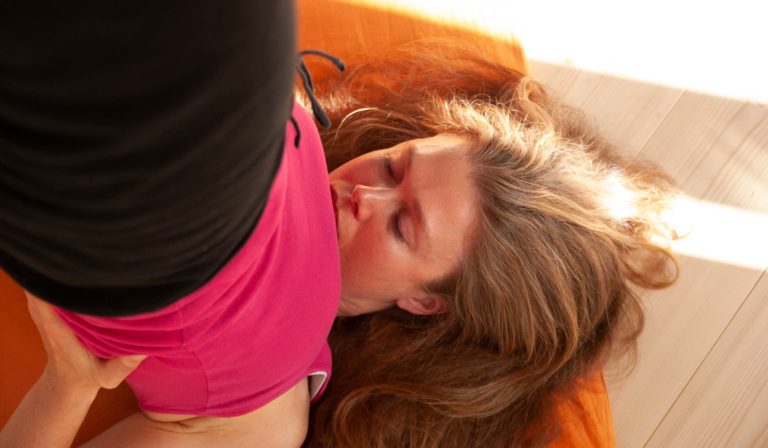The first time I read about the yoga teacher training at Haa Course Center, I immediately knew this was the training I wanted to do. That is why I came to live in Haa for almost five years. This article is about what it was like, and what I got out of going through the rare yoga teacher education under the guidance of Swami Janakananda and his life partner Swami Ma Sita.
Moving in at Haa Course Center
Arriving at Haa ashram in 2002
On the first of January 2002, I arrived by train in Älmhult in Småland in the south of Sweden. Älmhult is a sleepy small town. It is relatively unremarkable, save for the fact that the world headquarters of IKEA are situated here.
A yoga teacher from the ashram picked me up and drove me from the station through the dark snow dressed forest to the retreat center in Haa some 15 kilometres away.
The Swedish spelling of Haa used to be “Håå”, but in recent years someone has decided to change it to “Hå”. In English, it’s still spelt Haa.
Extensive sadhana before moving in
I had already been to Haa Course Center a year earlier. Then I had participated in a 14-day retreat over Christmas. I was 22 at the time, and was really touched by the course. Many of the participants were veterans, and the meditations were long and deep. It was the first time in my life that I had felt a sense of connection with the people around me. Though we were all different, it felt as if we on some level, all had something in common, something important. For the first time, I did not feel like a stranger.
Despite my positive experience, this two-week retreat also made me feel quite uncomfortable for no apparent reason. I had been unable to contain that uneasiness, and at the end of the two weeks, I was more than happy to leave. Nevertheless, a year later, I was back. This time I had signed up for the yearly three-month course, the flagship retreat of the center. To make it difficult for me to leave again, I had terminated the contract for my student flat. Moreover, I had moved all my belongings to my mother’s basement in an entirely different part of the country.
Coming to the retreat center in advance
I reckoned it was good to be there in advance. Therefore, I was several weeks early for my retreat.
The energy in the center was high. The first evening, the master, Swami Janakananda, held a satsang and guided meditation. Meditating together with a group of meditation professionals was powerful. As my subconscious opened up, that sense of discomfort came back at me with full intensity. I hardly slept that night (or at least it felt that way).
After my first retreat a year earlier, I had been an ardent practitioner. I maintained a seven-hour per day practice routine. Arriving in Haa, I carried on with my regular sadhana. The young yoga teachers who lived in the ashram were surprised to see me get up even earlier than they did to practice.
Meeting the ashramites in Haa Retreat Center
About ten young adults were living in the ashram. They were called ashramites and included several Germans, a woman from Finland and a few Danes and Swedes. There was also the eccentric Xavier who was half French and half Indian but who had grown up on the Channel Islands and spoke perfect British. The kitchen chef Christer had gotten trained in one of the top restaurants in Stockholm, Opera Källaren.
Swami Janakananda and Ma Sita lived a couple of kilometres away.
First time as a volunteer behind a retreat
The day after I arrived in the ashram, a ten-day retreat started. I was part of the team of volunteers that helped behind the scenes. It turned out to be another powerful experience. If my first 14-day course had been a little more uncomfortable than I had expected, just helping behind this course made me anxious for no apparent reason. Practising yoga on my own in my student flat had made me feel like a mountain of mental stability. But now, the volatility of my mood puzzled and disturbed me.
An experienced ashramite called Claudia saw how I was suffering and explained that as a helper behind a course, you feel what the participants are going through. She said that states, thoughts and emotions are not as personal as we think but that they extend around us. In the individual, the group state takes the form of one’s habitual internal dramas. In that way, it appears as a personal experience, though in reality, it is a shared one.
I was happy to hear that, and it made it a lot easier for me to relate to the heavy states that passed through me at times. This episode was my first encounter with a phenomenon I have experienced countless of times since and have learned to deal with without being swept away.
My three-month course in Haa Course Center
My three-month course started, and I was now a course participant. Slowly it built up in intensity and peaked during 33 days of silence. We were initiated into Kriya Yoga, the most advanced practices of the Satyananda tradition. As the weeks passed by, my mind calmed, my concentration grew, my breath slowed down, and my will power grew strong. I made peace with my subconscious.
Read my full review of the three-month course at Haa Retreat Center here >>>
But when the course was over, I was once again sure that being a yoga teacher was nothing for me and that I could go on studying business administration. On the last day I thanked everybody in the center and took the train to Stockholm.
Three weeks later, I was back again. But I told myself that I was only going to stay until the end of the summer.
Intense sadhana during my first summer in the ashram
The summer of 2002 was a marvellous one. Not only was it hot and sunny, but it was like living in a dream. I did karma yoga in the fields, the printery and in the kitchen. I helped the senior ashramites with whatever simple tasks I could. Yet, I did not have much responsibility, but plenty of time for yoga practice.
After my evening meditation, I aimed at being in bed at ten. That gave me four and a half hours of sleep until my alarm clock rang at 2:30 in the morning. After the three-month course, my need for sleep had dropped significantly. I was in the yoga room by three-o-clock, and when the other ashramites showed up a bit before six, I had already practised for three hours.
Before lunch, I would often have time for a session of concentration or yoga nidra, and in the afternoon, a long session of asana, pranayama and meditation.
Living in an extraordinary world
My mobile phone was confined to the ashram safe, and I had no access to the internet or even a computer. I called my parents a couple of times, but apart from that, I had no contact with the outside world. The furthest away I went from the center was the recycling bins for glass bottles in the nearby village.
These summer months were fantastic. Firmly anchored in myself from a long and intense sadhana, I felt like I was living outside of time in an extraordinary world.
Living in Haa Retreat Center as an ashramite
Some of the best years of my life
As planned, I tried to leave the center again after summer. I was however back after just a few days, and this time I was ready to commit.
The years that followed turned out to be some of the best of my life. Living in Haa made such an impression on me that to this day, twenty years later, memories from this period still arise in my dreams.
Becoming a karma yogi
Autumn came, and the days grew shorter and the nights longer. It became increasingly more challenging to get up early as the energy from the three-month course slowly faded. As a regular ashramite, I now had more and more responsibility. To my frustration, that meant that I had to give up my marathon sessions in the yoga room.
Instead, my sadhana slowly but surely geared towards karma yoga, the yoga of action. Karma yoga is an entire path of its own. It’s about devoting yourself to actions without being attached to the outcome or the fruits of the action. You give up your small self by working for a cause that goes beyond your interests, and in return, you connect with your greater self.
There is a synergy between one’s yoga sadhana and karma yoga. The energy and mental lucidity from practice fuels one’s actions and helps you to find satisfaction and meaning in even the most simple tasks.

Karma yoga is liberating
Karma yoga in this ashram revolved around running the retreats. As long as you were motivated enough to be a force to be reckoned with, there was a place for you. Being part of a group of people that all were eager to give their all for the yoga center was very inspiring.
I still had time to do several hours of yoga every day. But outside of the yoga room, I relentlessly engaged in activity, from early morning to late evening. Having karma yoga tasks without end is relieving. There is simply no time to get lost in self-pity from negative mind wandering.
Being active the whole day and maintaining perfect life hygiene also meant that I would sleep marvellously well. As impressive as it was, it would take me less than a couple of minutes to fall asleep at night.
Being part of a long tradition
To me, living at Haa Course Center felt like being part of something big. I knew that many others had done what I was doing before me. I often wondered what had become of them and how their time in the ashram had helped them to deal with whatever challenges life had led them to afterwards.
Haa Course Center had already existed for thirty years. Before that, our tradition traced its roots back to the Bihar School of Yoga. Beyond that, it went back to time immemorial through a web of countless forgotten yogis, sadhus and teachers.
I wanted to be a part of this tradition. I wanted to acquire the secret knowledge it possessed and become a teacher worthy of passing it down to others.
Yogic names
Those who wanted to connect even more to the tradition could ask Swami Janakanada for a spiritual name. It is common in many yogic lineages to ritually give up the name your parents gave you at birth and take on a new one. It is a means to lay off your old identity and be symbolically reborn.
Once in a while, someone would say that he or she was no longer Torsten or Tuula but Kaivalyananda and Agnidhara. These yoga names mean something. Usually, a quality achieved through yoga practice. It was always a bit exciting and solemn, and we would quickly forget the person’s old name. Indeed it was as if the renamed yogi absorbed some of the qualities expressed in their new names. Soon their old names would feel like belonging to a past life.
Attention training at Haa Retreat Center
An essential part of ashram life in Haa Course Center was attention training. This training happened, of course, during yoga and meditation practice. But it also occurred in the middle of daily activities. Swami Janakananda expected us to remain alert and attentive under any circumstance. If he felt like we had carried out some karma yoga task with less attention than needed, he had no qualms about prompting us to be more present.
Modern meditation research has coined the term “default mode”. That is the state an untrained mind gets into when idle. Contrary to what one might think, default mode induces plenty of neural activity in the brain. The material treated is thoughts revolving around yourself. You ruminate on your past, project yourself into the future, criticise yourself for your shortcomings and regret your mistakes. The default mode is a rather dark place.
Swami Janakananda had a talent for seeing when someone was gravitating towards default mode rather than being present. He had many creative methods for getting people out of it.
Learning to take responsibility
Swami Janakananda would stress the importance of doing your best. Actions that you don’t do with devotion and sincerity are never rewarding. But when you give your everything, actions become liberating. “Whenever you do something, do it well!” Swami Janakananda used to say.
Janakananda was a proponent of personal responsibility. He rejected being a victim of circumstances and urged us to take responsibility and make things happen. He was a role model in this respect.
As for myself, I was surprised by everything I managed to do in the ashram. I gained knowledge and skills in areas that had never before been in my scope of interest. I learned how to break through self-criticism and failure and how to go through with a job until I got it right.
Siddhis in everyday life
A siddhi is an extraordinary power achieved through yoga. Living in Haa Course Center gave me first-hand insights into this phenomenon in a very down to earth manner.
In the old yoga scriptures, it is stated that the practice of yoga brings about powers such as seeing at a distance or becoming incredibly strong. Research on telepathy and precognition affirms such phenomena. However, there is still strong resistance in the mainstream scientific community to accept the validity of this research. But the position of the old paradigm is increasingly more challenging to hold.
Most people have had the experience of thinking about someone seconds before receiving a call or text message from that very person. Living in Haa Course Center, with minimal influence from the outside, we experienced spontaneous telepathy frequently. I would often think about something just to hear someone else bring up the same topic in a discussion seconds later.
One of the most apparent occasions for me was during the three-month course in 2003. I was in charge of the kitchen, and I planned the menu. Food is a consolation when emotions are intense and for some of the participants what we were going to eat was a topic of keen interest.
On several occasions, a participant on the course came to ask me to put a specific meal on the menu. I used to say that I would consider it. But in reality, every time I had already planned the food she requested for one of the next meals.
A life without money
While I was living at Haa Course Center, I did not have any money. I had spent my last resources on the three-month course and to pay the rent during the first summer. From then on, Swami Janakananda allowed me to stay for free. I am so grateful for that.
That meant that for some years, I did not need any money. I got food, and I had a place to sleep. I dressed in clothes that had been left or forgotten by course participants.
Not having to think about earning money saves a lot of energy. Not having any did not bother me. I even thought that I might never have money again, and I was comfortable with that. For several years I did not have a single financial thought. That was a fantastic relief.
The history of Haa Course Center
When Swami Janakanandas started Haa Course Center, he bought the buildings from a hippie collective. According to the locals, these hippies used to dance naked in the fields and rumours had it (and they were probably right) that they took psychedelic drugs.
The local farmers had a hard time distinguishing the new yoga school from the old hippies. But as time went by a good relationship was established with the neighbours. Though they never stopped laughing at the yoga school’s farming techniques.
Little by little, Swami Janakakananda acquired more buildings around the main house. The school bought more land and rented some lots too. They even cleared a large patch of forest to make a new field, the Northland.
Janakanda improved the buildings and thanks to his audacious karma yoga projects he had basements dug out under several houses. There was always a new building project going on.
A peak interest in yoga and meditation
At the beginning of the 2000s, there was a peak in interest in yoga, and it was easy to attract course participants. At the same time, the tax department granted the school a considerable tax refund. Haa Retreat Center spent the money on improving its facilities. Janakanda let us add an extra layer of insulation on some of the buildings. We installed an entirely new water system as well as geothermal heating. Furthermore, we started raising the standard of student rooms.
Swami Janakananda’s yoga teacher training
The strengths of the teacher training at Haa Retreat Center
For most, the primary purpose of living in Haa Retreat Center was to participate in yoga teacher training. There was a lot that set this training apart from most other modern yoga teacher training courses. Janakananda’s approach was much like an old day apprenticeship. As students, we worked alongside him and other senior teachers and slowly absorbed their knowledge.
We learned yoga by experiencing it in ourselves and by seeing it acting in others rather than studying it or reading about it. “Why would you read books when you are together with those who write them?” Swami Satyananda had said to Janakananda when he lived with him in India in the late sixties.
Swami Janakanada aimed at creating yoga teachers. He had no interest in nurturing the curiosity of yoga amateurs, and therefore, studying theory was secondary. Having students who lived with him in the retreat center allowed for this hands-on approach.
Read more about the yoga teacher training in Haa Retreat Center in their official description>>>
A complete tradition
In many modern yoga traditions, there is an overfocus on asana. In Haa Retreat Center, on the other hand, we worked with the whole range of traditional yogic practices, not just the physical ones. There was, in fact, no specific focus on poses and no focus at all on physical perfection or alignment.
In Janakananda’s entourage there was a particular interest in pranayama. Probably because in his youth it has been one of his favourite practices. Janakananda and several teachers around him had taken pranayama to exceptional heights.
Various forms of meditation, including Kriya Yoga, were considered crucial.
Knowing theory is not enough to pass on yoga to others
You can’t transmit yoga through theory. A good yoga teacher should be an embodiment of yoga practice. A teacher should be able to inspire others to practice just through his or her radiance. None of the great teachers that made yoga famous during the last century went through a modern style yoga teacher training themselves.
Working behind the scenes of the courses at Haa Retreat Center
An essential part of Janakanandas training consisted of helping to run the retreat courses. That gave us aspirants a lot of practical know-how needed to organise retreats. It also gave us first-hand knowledge about the psycho-dynamics of the courses.
When you see group after group going through the same process, you quickly learn to distinguish between the different phases of a course. You notice how the yoga practices change the mood of the group and the psychic atmosphere in the whole center.
You learn how to motivate and encourage the participants, and also when to encourage someone who is not ready to leave.
Being a helping teacher at Haa Retreat Center
As you advanced in the yoga teacher training, you would at some point, become a helper in the yoga room. Becoming familiar with the energies in the yoga room during practice was exciting. The first time I was present as a helper during a session of breathing exercises, the energetic sensations I experienced blew me away.
Working as a helper to a more senior teacher in the yoga room gave you an introduction to what it was like to be a guide. It is quite different to lead than to be on the mat yourself. It allowed you to see how other teachers solved various issues and to learn from their particular priorities and styles.
Evening classes in neighboring towns
There came a time when we would start teaching ourselves. We would first practice on the other people living in the ashram, and when we were ready, we would teach evening courses in the neighbouring towns.
It was adventurous, leaving the shielded environment in the forest and venture into the ordinary world. Because of the sensitivity we got from our living conditions and extensive yoga practice, the encounter with everyday society was sometimes intense. And the teaching was too. We would feel the presence of the students and the effects of the practices we guided much more than one does living an ordinary city life teaching yoga.
After teaching, I would feel charged with energy and be in an incredibly light state of mind. The ride back through the dark forests to the ashram felt like travelling in a fairyland.

Seminars and retreats at Haa Course Center
The three-month course was the admission ticket to the training. Afterwards, we joined yearly retreats throughout the training: either a 14-day retreat or the one-month kriya course. These courses allowed us to intensify our practice. They also reminded us of what it was like to come to the center as a novice. I would pay special attention to instructions that I found particularly well formulated.
There were also teacher seminars three times a year. The teacher workshops were two-week retreats for everyone living in the ashram and teaching in affiliated schools. Teachers would come from all of Scandinavia, Germany and France. In total, we would be around thirty participants. Many were colourful and robust individuals.
During these courses, we not only got the possibility to immerse in practice but also to guide each other and to get feedback from other teachers.
As teacher aspirants living in Haa Retreat Center, we hence spent at least two months every year on retreat.
Being behind the three-month course
The yearly climax was the three-month course. Swami Janakananda led these courses in person. The participants were always highly motivated and in many cases, highly experienced. Consequently, the three-month courses were powerful. Being a helper behind such a programme was a rare opportunity for any yoga teacher.
As ashramites, we got to witness personal transformations and healing. We saw how tension and restlessness gave away for deep calm and exceptional concentration. But we also saw participants struggle with their internal dramas and the relief they felt when they finally let go. In the end, their faces were soft and shining.
An essential part of my training
I would consider being behind the three-month courses an essential part of the training I received. Teachers from affiliated centers also recognised the value of this course and came to help us.
I keep coming back to how the psychic atmosphere was influenced by what was going on at the courses. On the three-month retreats, this was of course, extra tangible. We could feel the vibrations from the meditations in the main yoga hall all the way to the ashram meditation room some 300 meters away. In the early morning hours, during the peak of the courses, I and the other ashramites would have stellar meditations as the course participants practiced Kriya Yoga.
Reintegrating into society
Leaving Haa Course Center
In the fall of 2006, after having spent almost five unforgettable years in Haa ashram, I was transferred to the Copenhagen city school. But I kept coming back frequently and still spent several months every year at the retreat center.
The school in Copenhagen had a fantastic location on the pedestrian street Købmagergade 65 in the middle of the city center. The whole building belonged to the yoga school. There were six yoga rooms when I lived there, and at the time it was considered not big enough. Yoga was booming, and what I had missed in Haa Retreat Center in terms of teaching evening classes I got here. I could almost teach as much as I liked, and I would occasionally have more than 40 hours of teaching per week.
Leaving the Scandinavian Yoga and Meditation School
When I was new, one of the teacher candidates said to me about ashram life that “First you have to break out of society, and then you have to break back in again”. If breaking out had been burdensome, breaking back in proved to be even more challenging.
Though I had benefited enormously from my years inside Janakanandas organisation, it had dawned on me that there were some drawbacks of being part of a closed club. Some attitudes that I had picked up, turned out to be useless or even counterproductive. I felt that I had to reevaluate some parts of what I had learnt.
Others who had slipped out of coherence with the organisation had run into difficulties. Swami Janakananda had even asked some people to leave. I did not want that to happen to myself, and I decided to go while I still had my banners high. As I did, I felt like a veteran leaving the military after long years of service in a faraway country.
Becoming a householder yogi
After I left Janakananda’s organisation, I became the driving force behind a yoga school in Paris, France. I met a wonderful woman and we got married. We have two boys today and live a busy and happy life as yoga teachers and parents.
The knowledge I gained in Janakananda’s ashram is always with me. Not only is it the basis of my work as a yoga teacher, but it influences my whole lifestyle.
In the yoga tradition, there are two types of yogis: the renunciates and the householders. When I lived in the ashram, I was a renunciate, but having left it, I have become a householder yogi. Both ways are valid and have their place.
I treasure the memories of my years in the ashram. The researcher and Buddhist meditation master Allan Wallace has said: “You can take a monk out of the monastery, but you can’t take the monastery out of the monk.” . The same goes for ashrams and yogis.
Special thanks to Anandananda for the photos.




